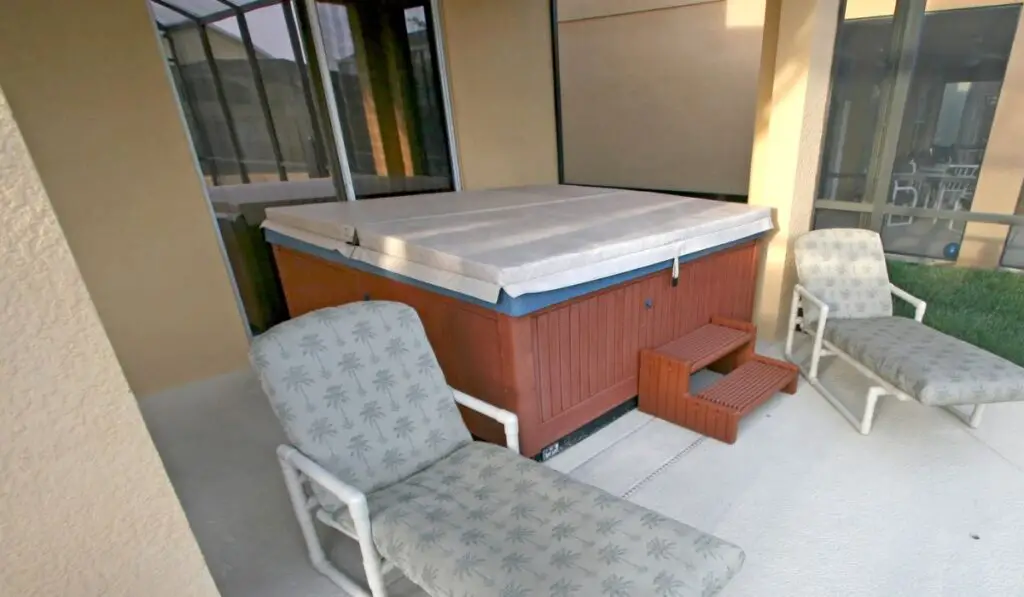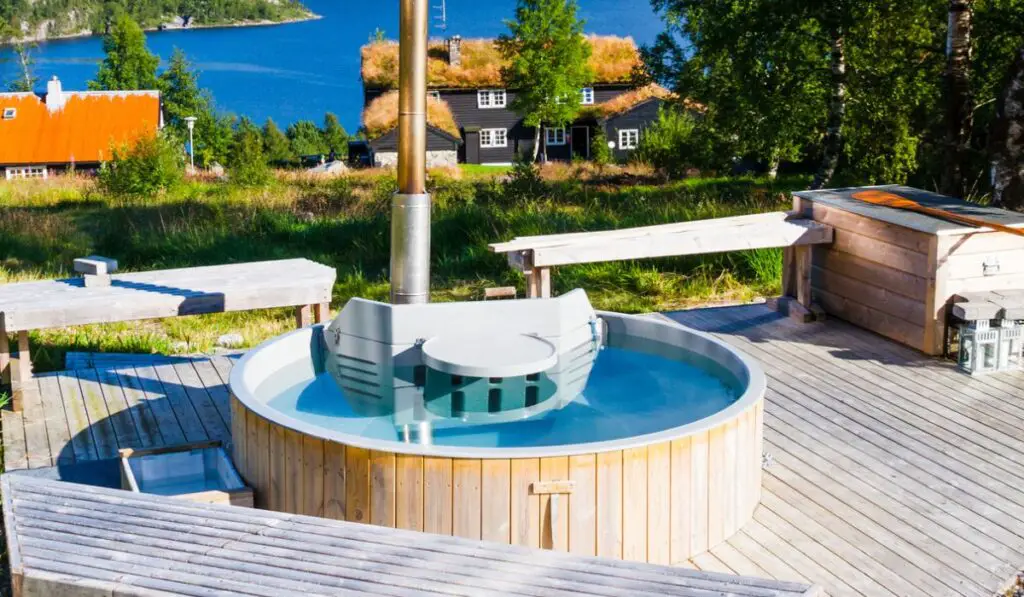Vacation time is every homeowner’s joy, whether you’re retreating to the Bahamas or taking the kids to Disneyland. But if you’re also a proud owner of a hot tub, you want to take proper care of it before leaving. Here’s what to know about maintaining a hot tub for your vacation:
First, test the water and balance it well. You should also remove and clean your filter cartridges or replace them if worn out. Next, add sanitizer, shock the tub, and seal it with a high-quality cover. Finally, you can lower the temperature by 10° to reduce heating costs.
Irrespective of the number of days you’ll be out, the weather, or the sanitizer you use, some hot tub maintenance procedures remain unchanged and crucial. Let’s get started so you figure out how to keep your hot tub pristine while you’re away.
Should You Turn Off Your Hot Tub While on Vacation?

You don’t need to turn off your hot tub when not in use, but you need to take proper maintenance measures to keep it in good working condition and ensure it’s safe for use.
The most obvious thing to do with electrical systems and appliances in your house is to turn them off before going away. However, your hot tub is a little different, and turning it off when going on vacation isn’t the best idea.
While you may think you’re saving some bucks that would’ve gone into your energy bills, you’re doing more harm than good.
Your hot tub won’t be able to circulate or filter the water, and it just stays there and probably grows yucky, slimy stuff if you don’t treat it well.
And if you turn it off in the winter months, water sitting in the shell and pipes will quickly freeze and expand, damaging the lines and equipment like the pump and filters. The tub’s shell could also develop irreparable cracks.
If you’re going away for one or two weeks, it’s better to balance the water and turn down the temperature by 5 or 10 degrees from the optimal soaking temperature. So if you enjoy your tub at 100℉, you can bring it down to 95 or 90℉ when leaving.
This is warm enough to prevent the water from freezing and damaging the pipes and equipment. Moreover, you’ll only need to heat it a little when you return.
How Should You Set Your Hot Tub When Not in Use?
Setting up your hot tub before heading out helps keep it in good shape and extend your relaxed vibes when you’re back.
Here’s how to prepare your tub for the days you’ll be out:
Test the Water and Balance it Properly

Use test strips (on Amazon) to check the water’s pH, alkalinity, and calcium hardness levels. You’ll then balance it as needed to protect the tub from scaling and corrosion. Moreover, it improves the sanitizer’s effectiveness against bacteria.
The alkalinity levels of the water should range between 100 and 150 ppm. As for the pH, stick with the recommended range of 7.4 to 7.6. You also want to maintain a calcium hardness level between 175 and 250 ppm.
If it exceeds this range, drain the tub, clean it thoroughly, and refill it with fresh water. You can also adjust the pH and alkalinity with a pH increaser (on Amazon) or an alkalinity increaser (on Amazon).
Clean the Filter Cartridges and Replace Old Ones
Over time, contaminants like dust, body creams, makeup, and bits of grass may accumulate in your filters and take a toll on their performance.
If your filter isn’t too old and worn out, rinse it thoroughly with your garden hose. But if it’s more than a year old and looks worn out, your only option is to replace it.
Add a Safe Dose of Sanitizer
Put in enough sanitizer (on Amazon) to get through your vacation days. Unless someone looks after your tub and rewards themselves by soaking in it, your sanitizer won’t be used up that fast.
So, if you’re using chlorine sanitizer, you can add 2 to 3 dichlor tablets and check that the chlorine level rests between 2 and 4 ppm.
Shock the Tub and Circulate the Water
Once you’ve sanitized your hot tub and balanced the water, it’s time to add a safe amount of spa shock.
Experts recommend a chlorine-based hot tub shock (on Amazon) as it’s more effective at killing algae and bacteria. It’s also good if you have a saltwater hot tub. Check the label to know the correct amount of shock to use.
When you’ve added the shock, run your pump for 15 to 20 minutes to circulate the water and distribute the chemicals evenly. You might want to do this as close to your departure as possible.
Seal Your Hot Tub Cover in Place
To protect your hot tub from the elements, debris, and critters, carefully seal the shell with a thick cover. Check to ensure no cracks, tears, or tiny holes will make the cover ineffective.
Setting Up the Tub Based on the Vacation Length
If you spend less than a week out of town, you can stick with the basic setup instructions we’ve discussed and expect to find your tub in the same elegant condition you left it.
But if you’ll be away for more than two weeks, you might want to have a trusted friend or neighbor pop in several times to monitor the water quality. If they can add in more sanitizer, the better. Of course, they get to take a refreshing soak as a reward if they want to.
If it’s been a while since you changed the water and you’ll be away for about two weeks, it’s time to drain your tub.
Next, clean the tub with a suitable cleaning agent and a non-abrasive sponge. Rinse it well and wipe it gently with another soft towel moistened with white vinegar to kill germs and algae cells. Finally, rinse the tub thoroughly and refill it with clean, filtered water.
Setting Up the Tub According to the Weather
If you live in a warm area, your primary concern is algae growth while you’re on vacation. That said, your best defense is to keep the sanitizer levels high to combat algae.
If you’re using chlorine, you can keep the level within the range of 5 to 8 ppm, like you would when starting a brand-new hot tub. You can then add algaecide to prevent algae bloom when you’re away.
But if you live in an area where temperatures get below freezing point in the winter, you want your hot tub’s plumbing to remain thawed. Provided the heater is running, you can drop the water temperature by up to 10 degrees to save on heating costs.
If you’ve installed a freeze protection system in your hot tub, it will automatically switch on the pump to circulate warm water when temperatures are almost freezing.
Otherwise, switch the heater on to maintain a consistently warm temperature and leave the pump running to circulate it.
Setting Up the Tub Based On Sanitizer
Chlorine is the most popular hot tub sanitizer and is the best option if you have an outdoor hot tub. However, you must stick with dichlor tablets or hot tub chlorinating granules. Do not use trichlor, as it could damage the acrylic shell of your hot tub.
You can also use bromine, especially if you have an indoor tub shielded from direct sunlight. Remember, bromine breaks down in sunlight, losing the chemical properties that make it work efficiently as a sanitizer.
You can either dissolve bromine tablets or add liquid bromine directly to the water. If you go for bromine tabs, load them in a bromine floater and turn the output setting down to the lowest.
Bromine usually gets released in the water slowly, meaning it won’t be used up fast when you’re away.
Other Hot Tub Maintenance Tips

Follow these additional maintenance tips to reduce the costs of operating your hot tub, keep it safe, and boost its longevity:
- Add a thermal blanket to improve insulation so you don’t overwork your heater.
- Place a thick, high-quality cover that fits snugly over the tub to protect it from the elements.
- Keep the tub clean at all times.
- Observe limits like the maximum number of allowed bathers to keep the tub safe and tidy.
- Shock the tub to prevent the growth of algae and bacteria.
- Check that your pump and filters are working correctly. For example, it’s likely clogged if the pump makes an unusually loud humming noise.
- Balance the water properly and test to ensure the chlorine level is within 3 to 8 ppm, with a pH of 7.4 to 7.6.
If, for some reason, you’re extending your vacation during the cold months, it’s best practice to drain and winterize your hot tub.
It will prevent water from freezing in the lines and damaging them. However, you can’t winterize a wooden tub for extended periods as you risk damaging its structure.

Монтаж оборудования для наблюдения обеспечит защиту территории в режиме 24/7.
Современные технологии гарантируют четкую картинку даже в ночных условиях.
Вы можете заказать множество решений устройств, подходящих для бизнеса и частных объектов.
videonablyudeniemoskva.ru
Качественный монтаж и сервисное обслуживание делают процесс эффективным и комфортным для любых задач.
Свяжитесь с нами, для получения лучшее решение в сфере безопасности.